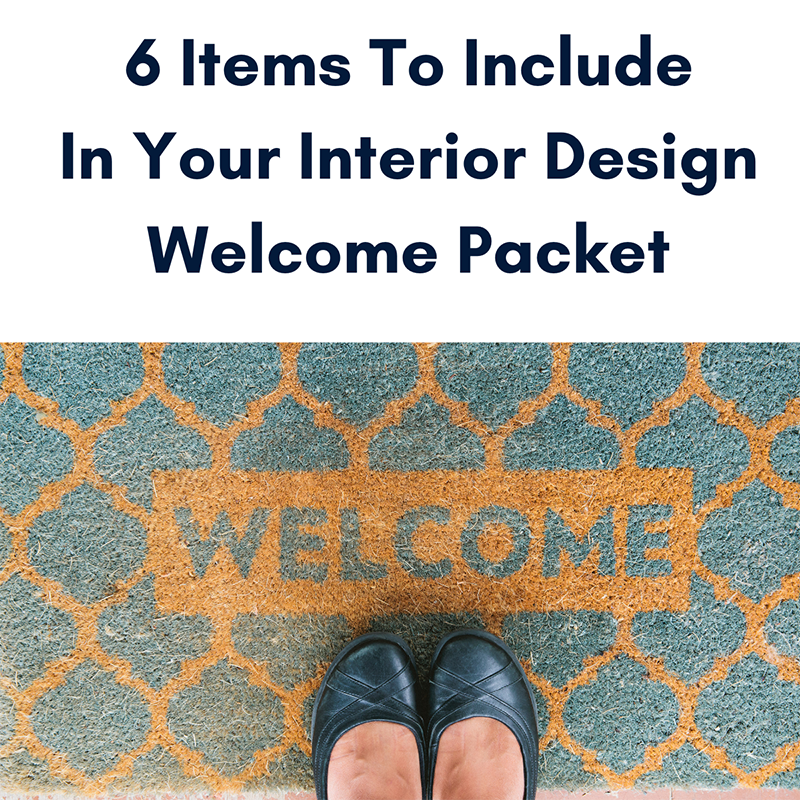Interior design is a very competitive industry, so it is crucial to make a good first impression on your clients. One way to do that is by providing them with a clear and cohesive welcome packet when they sign on to work with you. It’s always best to keep your client informed from the very start of a project, so that they have the tools they need to feel supported throughout the process. But with so many details to manage, you may be wondering what to cover and how to avoid overwhelming them. Check out these 6 items to include in your interior design welcome packet!
1. Overview of Services
First and foremost, it is a good idea to include an overview of your services. It can be a simple one-page document, but be sure to have short descriptions for each type of service that you offer. Clients who have never hired an interior designer may be unfamiliar with their options, so this document serves as an introductory guide for them. It can help them identify their goals and expectations for a project.
An overview is also a great marketing material to highlight unique services, call out your specialties, and indicate what sets you apart from your competition. For example, you might include a section about the convenience of virtual design or talk about your experience with Airbnb design. It never hurts to make your clients aware of all your offerings. Sometimes it can lead to additional work or referrals!
2. Design Process Outline
Once your client understands what you offer, they need to know how you plan to implement it. You can explain this with an outline of your design process in the welcome packet. This will help you ensure that your client knows how you operate and what the process entails before you commit to working with them. The process will run much more smoothly if you can clear up confusion before any work begins.
When compiling this document, it’s important to make sure that you are not too vague or too specific. We recommend dividing the project into phases when you break it down for your client. Think about the main points that they really need to understand about the process, like what happens during each phase and when they can expect deliverables. You want to give them enough information to understand what will happen without overwhelming them with all the little details and tasks that take place behind the scenes.
3. List of Policies
Like the outline of your design process, a list of general company policies will help your client understand how your business operates. It also protects your business and allows you to avoid some frustrations on the job, such as never-ending projects, profit losses, and clients who are upset about unexpected delays. It is much easier to set and maintain boundaries at the start of a project than it is to try and enforce new boundaries once the project is underway.
Focus on policies that are always true for every project you accept, and make sure the wording is clear and concise. You should address topics such as:
- Working hours
- Means of communication
- Maximum number of revisions
- Payment terms & structure
- Order cancellations
- Refunds on purchases
- Timeline
- Work by contractors & tradespeople
Once your client has reviewed these policies, they can make a more informed decision about whether or not you are the right designer for them. However, keep in mind that this list is not a replacement for a contract. A contract covers the specifics of a particular project in much greater detail, and a client should always sign a contract before work begins. Check out this blog for more information about what to include in a contract.
4. Questionnaire
A welcome packet is a professional way to introduce yourself to your client, but it can also provide value to you as the designer, too. Just as your client is getting to know you, you can learn more about your client by including a questionnaire for them to complete. Use it to gather details that you can reference when you are sourcing and compiling specifications. Your questionnaire can include questions about their lifestyle, needs, goals, likes and dislikes, and style preferences. This will help you ensure that the final design fulfills their needs and desires.
5. Testimonials
You can reference a questionnaire to produce beautiful end results for your client, but how do you convince someone to use your services in the first place? Testimonials are a great resource because they help you build trust and credibility with your client. The more detailed they are, the better. Choose three to five of your favorite testimonials to showcase in your welcome packet, and let your previous clients’ praises sell your services for you.
6. Contact information
Last but not least, don’t forget to include your contact information! Most clients appreciate it when the lines of communication are open and you are accessible when they need to ask questions. Although they may already have your information, it’s always a good idea to include it again in case it gets lost or misplaced. This will help them feel like they have support throughout the process. And if they don’t need your information, you never know if they might pass it along to a friend as a referral.
You can contribute to a positive experience for your clients by including these 6 items in your interior design welcome packet. These items will provide your clients with the resources they need to feel supported and give them the confidence to trust in your services. A good design experience means happy clients, and happy clients can mean more positive reviews for your business.
You don’t have to sacrifice the quality of your interior design welcome packet even if you’re short on time. The 4Dbiz team of virtual design assistants can help you develop materials that polish your professionalism, wow your clients, and help you navigate smoothly through the design process. Register today to enhance your business success!

